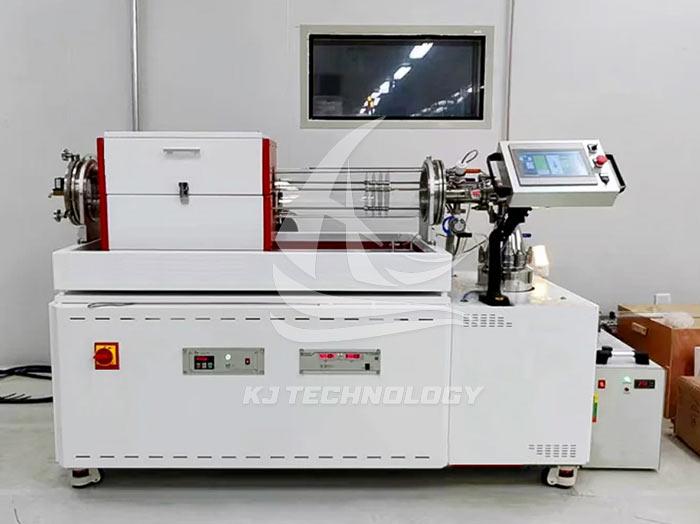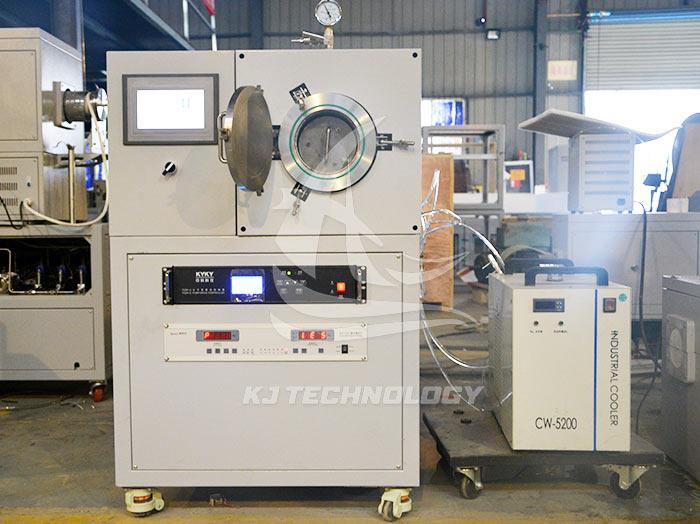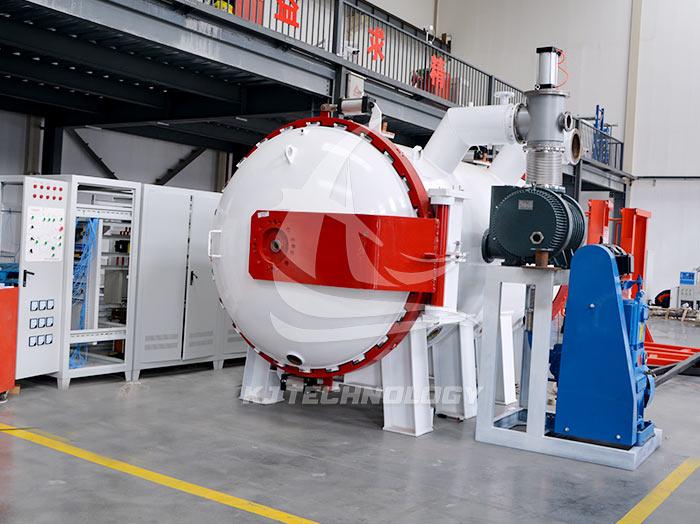Working principle of vertical high vacuum hot pressing electric furnace
 08-20-2025 Author: KJ technology
08-20-2025 Author: KJ technology
Vertical high vacuum hot press electric furnace is an advanced material processing equipment that integrates vacuum environment, high-temperature heating, and mechanical pressure. Its working principle is achieved through the synergistic effect of three core links: vacuum environment creation, high-temperature heating, and mechanical pressure forming, to achieve material densification or hot press forming. The following is a detailed explanation:
1. Creating a vacuum environment
Vacuum pumping process:
After the equipment is started, the vacuum system (usually composed of mechanical pumps and molecular pumps) begins to work, gradually extracting the air from the furnace chamber.
The mechanical pump is responsible for initial pumping, reducing the furnace chamber pressure to a certain range (such as the order of 10 ⁻¹ Pa), and then the molecular pump takes over, further reducing the pressure to an ultra-high vacuum state (such as 10 ⁻⁴ to 10 ⁻⁵ Pa).
The creation of a vacuum environment is a key prerequisite for hot pressing technology, which can effectively prevent materials from reacting with gases such as oxygen and nitrogen at high temperatures, prevent oxidation, volatilization, or pollution, and ensure the stability of material properties.
Vacuum degree control:
The furnace chamber is equipped with a high-precision vacuum gauge, which monitors pressure changes in real time and automatically adjusts the operating status of the vacuum pump through the control system to maintain the set vacuum degree.
Some devices also support filling inert gases (such as argon) as a protective atmosphere to further optimize the process environment.
2. High temperature heating implementation
Heating method:
Vertical high vacuum hot pressing electric furnaces usually use graphite carbon tube heating or induction heating methods.
Graphite carbon tube heating: By using the principle of resistance heating, electrical energy is converted into thermal energy and evenly transmitted into the furnace cavity. Graphite materials have high melting points, high thermal conductivity, and chemical stability, making them suitable for high-temperature environments.
Induction heating: Using the principle of electromagnetic induction, eddy currents are generated in metal materials to achieve rapid heating. Induction heating has the characteristics of fast heating speed and high thermal efficiency, but the appropriate frequency and power need to be selected according to the material properties.
Temperature control:
The furnace chamber is equipped with high-precision temperature sensors (such as tungsten rhenium thermocouples) to monitor temperature changes in real time and provide feedback to the control system.
The control system adopts PID algorithm to automatically adjust the heating power based on the deviation between the set temperature and the actual temperature, achieving precise temperature control (usually with an accuracy of ± 1 ℃).
Support multi-stage program heating function, users can set different heating rates, insulation times, and target temperatures according to process requirements to meet the requirements of complex heat treatment processes.
Temperature uniformity:
The furnace chamber design adopts a vertical structure, combined with a reasonable layout of heating elements and an airflow circulation system, to ensure uniform temperature distribution inside the furnace and avoid local overheating or underheating phenomena.
Some high-end devices are also equipped with temperature field simulation software, which can pre optimize the heating scheme and further improve temperature uniformity.
3. Mechanical compression molding
Pressure system:
The equipment is equipped with a hydraulic system, which drives the piston through a high-pressure oil pump and drives the pressure head to apply pressure to the material.
The pressure range usually ranges from several tons to several hundred tons and can be adjusted according to material characteristics and process requirements.
The pressurization methods include unidirectional pressurization and bidirectional pressurization, and bidirectional pressurization can further improve the density and uniformity of the material.
Pressure control:
The pressure sensor monitors the pressure applied by the pressure head in real time and feeds back the data to the control system.
The control system automatically adjusts the output of the hydraulic system based on the deviation between the set pressure and the actual pressure, achieving precise pressure control (usually with an accuracy of ± 0.1MPa).
Support pressure maintenance function, which can maintain a constant pressure during the insulation stage and promote the densification process of materials.
The synergistic effect of pressurization and heating:
In high temperature environments, materials are in a thermoplastic state, and applying pressure can promote sliding and rearrangement between particles, eliminate pores, and improve the density of the material.
The synergistic effect of pressure and temperature can significantly reduce the sintering temperature of materials, shorten sintering time, and improve production efficiency.
For certain special materials, such as metal matrix composites, hot pressing technology can also improve the interfacial bonding strength and enhance the overall performance of the material.
4. Typical process flow
Loading: Place the material to be processed (such as powder, prefabricated parts) into the mold inside the furnace cavity and fix the position of the pressure head.
Vacuum pumping: Start the vacuum system to reduce the furnace chamber pressure to the set value.
Heating up: Heat up according to the preset program to the target temperature while maintaining a vacuum environment.
Pressurization: After reaching the target temperature, activate the hydraulic system to apply pressure to the material and maintain it for a certain period of time.
Insulation and pressure maintenance: Maintain a set temperature and pressure for a period of time to promote the densification or phase transition process of the material.
Cooling: Stop heating and pressurization, and cool the material to room temperature through natural cooling or forced cooling (such as gas circulation cooling).
Material retrieval: Open the furnace chamber, retrieve the processed material, and proceed with subsequent processing or testing.








